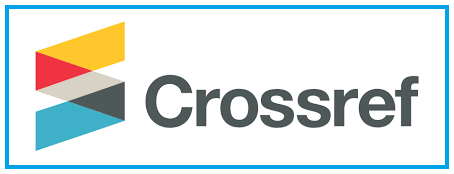TREN RISET PASCAPANEN EDIBLE FLOWER
Keywords:
agricultural science, bibliometric, biological science, Mediterranean countries, Scopus Advanced Search, value and benefits for consumersAbstract
The topic of scientific publications related to postharvest edible flowers is still very rare in Indonesia. In fact, edible flowers are one of the potential foods that can help achieve the Sustainable Development Goals (SDGs) related to alleviation and hunger. This article aims to provide information on research trends published on the Scopus Index related to the postharvest topic of edible flowers in the period 2017 to 2021. The methods used were using Scopus Advanced Search and bibliometric analysis using the VOSviewer. The results showed that there were 186 publications related to postharvest edible flowers. The subject area is dominated by agricultural and biological sciences. Countries that have concerns about this topic are dominated by countries in the Mediterranean region. There are three main clusters based on bibliometric analysis and current trends tend to focus on the cluster area of value and benefits for consumers. This article also provides information related to topics that have not been widely obtained so that they can provide benefits for stakeholders who may need it for future research.
Downloads
References
Amrouche, T. A., X. Yang, E. Ç. Guven, W. Huang, Q. Chen, L. Wu, Y. Zhu, Y. Liu, Y. Wang, and B. Lu. 2022. “Contribution of Edible Flowers to the Mediterranean Diet: Phytonutrients, Bioactivity Evaluation and Aplications.” Food Frontiers, 1–39. https://doi.org/10.1002/fft2.142.
Anjarsari, I. R. D., Murgayanti, and E. Suminar. 2022. “Pemanfaatan Bunga Mawar Untuk Konsumsi Di Desa Cileles Kecamatan Jatinangor Kabupaten Sumedang.” Dharmakarya: Jurnal Aplikasi Ipteks Untuk Masyarakat 11, no. 2: 172–75. https://doi.org/10.24198/dharmakarya.v11i2.33491.
Ashari, S. 2006. Hortikultura Aspek Budidaya. Jakarta: UI PRess.
Bagaihing, M., and C. M. Mantolas. 2021. “Kuliner Lokal Sebagai Produk Budaya (Studi Kasus Pada On The Rock Hotel, Kupang).” Journey : Journal of Tourismpreneurship, Culinary, Hospitality, Convention and Event Management 4, no. 2: 211–24. https://doi.org/10.46837/journey.v4i2.93.
Haris, J., and W. Syarif. 2022. “Inventarisasi Resep Nasi Pangek Pada Acara Adat Turun Mandi Di Nagari Pariangan.” Jurnal Pendidikan Tambusai 6, no. 2: 16426–32. https://doi.org/10.31004/jptam.v6i2.5040.
Hartanto, R., S. R. F. Fitri, Kawiji, S. Prabawa, B. Sigit, and B. Yudhistira. 2021. “Analsis Fisik, Kimia, Dan Sensoris Teh Bunga Krisan Putih (Chrysanthemum Morifolium Ramat.) Dengan Pengeringan Kabinet.” Agrointek 15, no. 4: 1011–25. https://doi.org/10.21107/agrointek.v15i4.10531.
Isabella, M. O., I. N. K. Putra, and G. A. K. D. Puspawati. 2021. “Pengaruh Perbandingan Daun Putri Malu (Mimosa Pudica Linn.) Dan Bunga Melati (Jasminum Sambac (L.) Ait.) Terhadap Karakteristik Teh Celup Wangi.” Jurnal Itepa 10, no. 4: 548–57. https://doi.org/10.24843/itepa.2021.v10.i04.p01.
Kuswati, and W. C. Adi. 2021. “Gathering Nutritious Edible Wild Plants Based on Societies Indigenous Knowledge from Sempolan, Jember Regency.” Jurnal Biologi Tropis 21, no. 2: 393–402. https://doi.org/10.29303/jbt.v21i2.2607.
Marini, S. 2020. “Analisis Minat Beli: Dampak Dari Pengetahuan Produk Edible Flower (Studi Kasus Pada Restoran-Restoran Di Kota Bandung).” Tourism Scientific Journal 6, no. 1: 37–54. https://doi.org/10.32659/tsj.v6i1.119.
Marsigit, W. 2010. “Pengembangan Diversifikasi Produk Pangan Olahan Lokal Bengkulu Untuk Menunjang Ketahanan Pangan Perkelanjutan.” Agritech 3, no. 4: 256–64. https://doi.org/10.22146/agritech.9717.
Martini, N. K. A., I. G. A. Ekawati, and P. T. Ina. 2020. “Pengaruh Suhu Dan Lama Pengeringan Terhadap Karakteristik Teh Bunga Telang (Clitoria Ternatea L.).” Jurnal Itepa 9, no. 3: 327–40. https://doi.org/10.24843/itepa.2020.v09.i03.p09.
Maruapey, A., S. Ohorella, and S. Karepesina. 2022. “Nilai Kepentingan Budaya Keanekaragamaan Jenis Sayuran Indegenous Dalam Kehidupan Masyarakat Di Kampung Sire Distrik Mare Timur Kabupaten Maybrat Papua Barat.” Jurnal Agrohut 13, no. 1: 11–24. https://doi.org/10.51135/agh.v13i1.119.
Marveldani, E. Maulana, and Dulbari. 2022. “Aplikasi Jenis Pupuk Nitrogen Dengan Metode Fertigasi Kapiler Pada Tanaman Pohpohan (Pilea Trinervia Wrigth).” Planta Simbiosa 4, no. 1: 1–14. https://doi.org/10.25181/jplantasimbiosa.v4i1.2519.
Maulina, E., M. Purnomo, and I. Abdurahman. 2021. “Analisis Bibliometriks Dan Visual Terkait Corporate Entrepreneurship Menggunakan VOSviewer.” Jurnal Inspirasi 12, no. 2: 106–16.
Nurrahma, A. H. I., H. H. Putri, and R. M. Syahadat. 2023. “Scientific Research Trends of Flooding Stress in Plant Science and Agriculture Subject Areas (1962-2021).” ASEAN Journal of Science and Engineering 3, no. 2: 163–78. https://doi.org/10.17509/ajse.v3i2.46148.
Pribadi, E. M., and T. K. K. Azmi. 2019. “Pertumbuhan Vegetatif Sayuran Indigenous Daun Walang Liar (Eryngium Foetidum) Pada Beberapa Kombinasi Perlakuan Jenis Media Tanam Dan Dosis Pupuk.” Jurnal Pertanian Presisi 3, no. 1: 33–42. https://doi.org/10.35760/jpp.2019.v3i1.1973.
Roni, A. 2018. “Pemanfaatan Tumbuhan Tespong (Oenanthe Javanica DC), Sintrong (Cressocephalum Crepidioides), Dan Pohpohan (Pilea Trinervia W) Dalam Menghambat Pertumbuhan Bakteri Staphylococcus Epidermidis & Pseudomonas Aerugenosae.” Journal of Pharmacopolium 1, no. 3: 122–30. https://doi.org/10.36465/jop.v1i3.428.
Safitri, N. T., B. Tanius, and N. N. Widanim. 2022. “Modifikasi Hidangan Penutup Barat Menggunakan Bunga Kecombrang.” Journey : Journal of Tourismpreneurship, Culinary, Hospitality, Convention and Event Management 5, no. 1: 63–70. https://doi.org/10.46837/journey.v5i1.103.
Saleh, I., U. Trisnaningsih, D. Dwirayani, R. M. Syahadat, and I. S. W. Atmaja. 2020. “Analisis Preferensi Konsumen Terhadap Dua Spesies Kenikir; Cosmos Caudatus Dan Cosmos Sulphureus.” MAHATANI 3, no. 1: 195–204. https://doi.org/10.52434/mja.v3i1.916.
Santosa, E., S. Zaman, D. Guntoro, and A. D. Susila. 2020. “Agroecology and Uses of Galinsoga Parviflora as Indigenous Vegetable in Highland of Kuningan, Banjarnegara and Wonosobo, Indonesia.” J. Agron. Indonesia 48, no. 3: 339–47. https://doi.org/10.24831/jai.v48i3.32800.
Suwandi, R. P., D. Turgarini, and R. Fitrianti. 2014. “Kesadaran Mahasiswa Terhadap Penggunaan Edible Flowers Sebagai Garnish Dalam Penyajian Makanan (Studi Kasus: Mahasiswa Pengolah Makanan Pada Program Studi Pariwisata Universitas Pendidikan Indonesia Dan STP Bandung).” The Journal Gastronomy Tourism 1, no. 2: 125–37. http://download.garuda.kemdikbud.go.id/article.php?article=2448240&val=23379&title=Kesadaran Mahasiswa Terhadap Penggunaan Edible Flowers Sebagai Garnish Dalam Penyajian Makanan Studi Kasus Mahasiswa Pengolah Makanan Pada Program Studi Pariwisata Universitas Pendidikan Indonesia dan STP Bandung.
Syahadat, R. M., and I. Saleh. 2020. “Penilaian Performa Daun Dan Tajuk Cosmos Sulphureus Cav. Terhadap Pemupukan Organik Dan Anorganik.” Jurnal Pertanian Presisi 4, no. 1: 29–38. https://doi.org/10.35760/jpp.2020.v4i1.2804.
Tupan. 2016. “Pemetaan Bibliometrik Dengan VOSviewer Terhadap Perkembangan Hasil Penelitian Bidang Pertanian Di Indonesia.” Visi Pustaka 18, no. 3: 217–30. https://doi.org/10.37014/visi%20pustaka.v18i3.132.
Widajati, E., E. Murniati, E. R. Palupi, T. Kartika, M. R. Suhartanto, and A. Qadir. 2013. Dasar Ilmu Dan Teknologi Benih. Bogor: IPB Press.
Yurlisa, K. 2016. “Peran Sayuran Indigenous Dalam Ketahanan Pangan Rumah Tangga Di Indonesia.” Jurnal Hijau Cendekia 1, no. 2: 18–22. https://ejournal.uniska-kediri.ac.id/index.php/HijauCendekia/article/view/118/98.
Yurlisa, K., M. D. Maghfoer, N. Aini, and W. S. D. Yamika. 2018. “Preferensi Konsumen Terhadap Atribut Kualitas Tiga Jenis Sayuran Indigenous Di Jawa Timur, Indonesia.” J. Hort. Indonesia 9, no. 3: 158–66. https://doi.org/10.29244/jhi.9.3.158-166.
Downloads
Published
How to Cite
Issue
Section
License
Copyright (c) 2022 SENTRI: Jurnal Riset Ilmiah

This work is licensed under a Creative Commons Attribution-NonCommercial-ShareAlike 4.0 International License.









